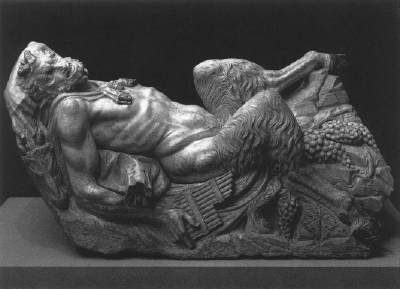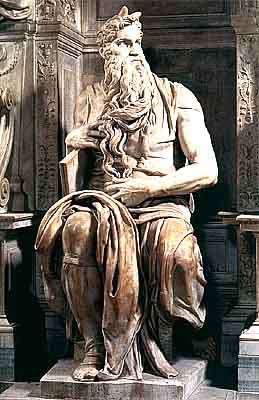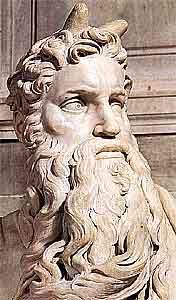The Satyr

The saying goes "art imitates life". One of my favorite characters of Saturday Night Live is Jim Breuer's impression of a half-man, half-goat, simply dubbed as "Goatboy" [Shown above]. Breuer, may have sub-consciously stumbled upon this persona on accident, as he claims in a May, 2 2003 article of Variety, "Goatboy actually started out as me pretending to have Tourette's [syndrome]". Whatever the case may be the character struck a chord in my psyche, when the laughter subsided. Then it dawned on me.
What Jim Breuer had brought to life was none other than the mythological Satyr. In this section of NagaFangzahne: The Lost Tribes of Gaia I present the following question: What if many of the so-called mythological creatures described in human legends were actually flesh and blood beings? Furthermore, what if the reason they are resigned to myth is because if our memory served us, the recollection would reveal our hand in their extinction.
It is not to far-fetched of a hypothesis. For millenia, the Jewish peoples were scattered and persecuted all over the face of the Earth. Their enemies used pogroms(1) and holocausts (2)to bring about their destruction. Fortunately, they did not succeed. Allow me to pose a horrible scenario. What if they had succeeded in exterminating all Jews from the face of the Earth? One probability is that at some future date, their memory would be resigned to legend and myth. They would be remembered as "demons" or "evil spirits" that plagued civilization. Their image would be mocked and ridiculed for generations. As it stands today, and in the past many peoples have relegated the Jews to the status of persona non grata (3).
The reason for this exegesis, may be unclear to you the reader, but in my mind, the attrocities inflicted upon the Jews over the past, has happened to other groups. Some human. Some were not. This blog speaks on behalf of a group known collectively as the Satyr.
Giovanni Angelo Montorsoli and the Drunken Satyr

All sources agree that the Satyr is represented as Half-man, half-goat. Bearded, sometimes with horns or goat's ears. The title of this statue seems to says it all.
Take careful note of the grapes and the windpipe flute. Why did Montorsoli, a master sculptor and architect, feel the need to create this piece of work in hommage to the Satyr? What is its meaning? What inspired him to create it?
Perhaps the inspiration came from Montorsoli's teacher himself, Michelangelo? One peculiar sculpture of Michelangelo's that comes to my mind is his sculpture of the biblical hero of the Exodus narrative, Moses [shown below]

Take note of the horns on the head of Moses. Michelangelo, it seems never left behind a journal or inscription explaining the purpose of the horns. As such, they have elicited various interpretations.

One source claims that: "The likeliest explanation is that Michelangelo relied on Jerome's vulgate translation of the Old Testament. In this commonly available version, the "rays of light" that were seen around Moses' face after his meeting with God on Mt Sinai were expressed as horns. Some people believe that Jerome's intention was to express a metaphor for the glory of God reflected from Moses's face."
Interesting. But is it probable? I do not think so. The author of this explanation is obviously a stranger to the Scriptures and to history itself. Certainly, Montorsoli learned a thing or two from Michelangelo? When I look at the Drunken Satyr, a particular scripture comes to mind:
Genesis 9:20-21
"Noah, a man of the soil, proceeded to plant a vineyard. When he drank some of its wine, he became drunk and lay uncovered inside his tent."
More Analysis
Could the Drunken Satyr be Montorsoli's depiction of Noah? If this is so, then the grapes in the sculpture would serve to allude to Noah's vineyard. But the grapes and the vineyard are allegories themselves! Are they not? Allow me to unravel this intriguing parable.
First allow me to demonstrate how this parable of vineyards, wine, blood of grapes, etc. is used commonly throughout the Bible as a metaphor for hereditary bloodlines, and the systematic holocaust or devastation of a given hereditary bloodline. All in all, "blood" is the central theme.
Let us begin with the Prophet Isaiah, who ministered for over 40 years during the reigns of four Judean kings: Uzziah, Jotham, Ahaz, and Hezekiah. Isaiah posed the following rhetorical question:
Who is this coming from Edom, from Bozrah, with his garments stained crimson?
Who is this, robed in splendor, striding forward in the greatness of his strength? "It is I, speaking in righteousness, mighty to save."
"Why are your garments red, like those of one treading the winepress?" 63:2
"I have trodden the winepress alone; from the nations no one was with me. I trampled them in my anger and trod them down in my wrath; their blood spattered my garments, and I stained all my clothing."
Genesis 49:11
He will tether his donkey to a vine, his colt (Hebrew translation: ben ha aton) to the choicest branch; he will wash his garments in wine, his robes in the blood of grapes.
Revelation 19:11-21
"11I saw heaven standing open and there before me was a white horse, whose rider is called Faithful and True. With justice he judges and makes war. 12His eyes are like blazing fire, and on his head are many crowns. He has a name written on him that no one knows but he himself. 13He is dressed in a robe dipped in blood, and his name is the Word of God. 14The armies of heaven were following him, riding on white horses and dressed in fine linen, white and clean. 15Out of his mouth comes a sharp sword with which to strike down the nations. "He will rule them with an iron scepter."[a] He treads the winepress of the fury of the wrath of God Almighty. 16On his robe and on his thigh he has this name written:
17And I saw an angel standing in the sun, who cried in a loud voice to all the birds flying in midair, "Come, gather together for the great supper of God, 18so that you may eat the flesh of kings, generals, and mighty men, of horses and their riders, and the flesh of all people, free and slave, small and great."
19Then I saw the beast and the kings of the earth and their armies gathered together to make war against the rider on the horse and his army. 20But the beast was captured, and with him the false prophet who had performed the miraculous signs on his behalf. With these signs he had deluded those who had received the mark of the beast and worshiped his image. The two of them were thrown alive into the fiery lake of burning sulfur. 21The rest of them were killed with the sword that came out of the mouth of the rider on the horse, and all the birds gorged themselves on their flesh."
Ezekiel 39:17-20
17 "Son of man, this is what the Sovereign LORD says: Call out to every kind of bird and all the wild animals: 'Assemble and come together from all around to the sacrifice I am preparing for you, the great sacrifice on the mountains of Israel. There you will eat flesh and drink blood. 18 You will eat the flesh of mighty men and drink the blood of the princes of the earth as if they were rams and lambs, goats and bulls—all of them fattened animals from Bashan. 19 At the sacrifice I am preparing for you, you will eat fat till you are glutted and drink blood till you are drunk. 20 At my table you will eat your fill of horses and riders, mighty men and soldiers of every kind,' declares the Sovereign LORD."
One source states that Satyrs are "Prone to drinking, partying and lusting after women. In Greek mythology, the god of the woods, Pan, is a satyr."
Another source echoes the same and offers a bit more detail stating that the "(Satyroi) Mountain spirits...represented the fertility of the wilderness. They appeared as men with the ears and tail of an ass. The goat-legged satyrs were known as Panes and the elder ones as Sileni."
Might Actually be Orangutan
Described by Pliny- "Among the mountainous districts of the eastern parts of India, in what is called the country of Catharcludi, we find the Satyr, an animal of extraordinary swiftness. They go sometimes on four feet, and sometimes walk erect; they have, also, the features of a human being."
Isidore of Seville- "The Satyrs are manikins with upturned noses; they have horns on their foreheads, and are goat-footed, such as the one St. Anthony saw in the desert. And he, being questioned, is said to have answered the servant of God, saying, "I am mortal, one of the inhabitants of the waste, whom the heathen, misled by error, worship as the Fauns and Satyrs.""
________________
Sigmund Freud wrote several essays about Moses and one essay devoted to his thoughts about this sculpture, The Moses of Michelangelo. Freud first visited in Rome in September, 1901 and saw the statue in the Church of St Peter in Chains. On subsequent visits to Rome, which usually occurred in late summer, he made a point of going to see "his" Moses.
Eventually Freund confided to friends his interest in writing about the compelling statue. Anonymously in 1914 he published a paper in the psycholanalytic journal Imago. Although many people seemed to know to whom the work belonged, he did not acknowledge his authorship of the paper until 1924. The drawing at left is one of several that illustrate the essay, which is filled with meticulous observations about various aspects of the statue.
(1) Pogrom is Russian for "devastation"
(2) Holocaust means "burnt whole, or burnt offering"
(3)Persona non grata


0 Comments:
Post a Comment
<< Home